Getting your snowmobile’s track adjusted correctly doesn’t have to be complicated. In this guide, we’ll show you the tools, step-by-step instructions, and troubleshooting tips for all major brands — Polaris, Ski‑Doo/Lynx, Arctic Cat, Yamaha, and more. If you do it right, your snowmobile will run great quickly. Why Track Tension Matters Track tension directly affects […]
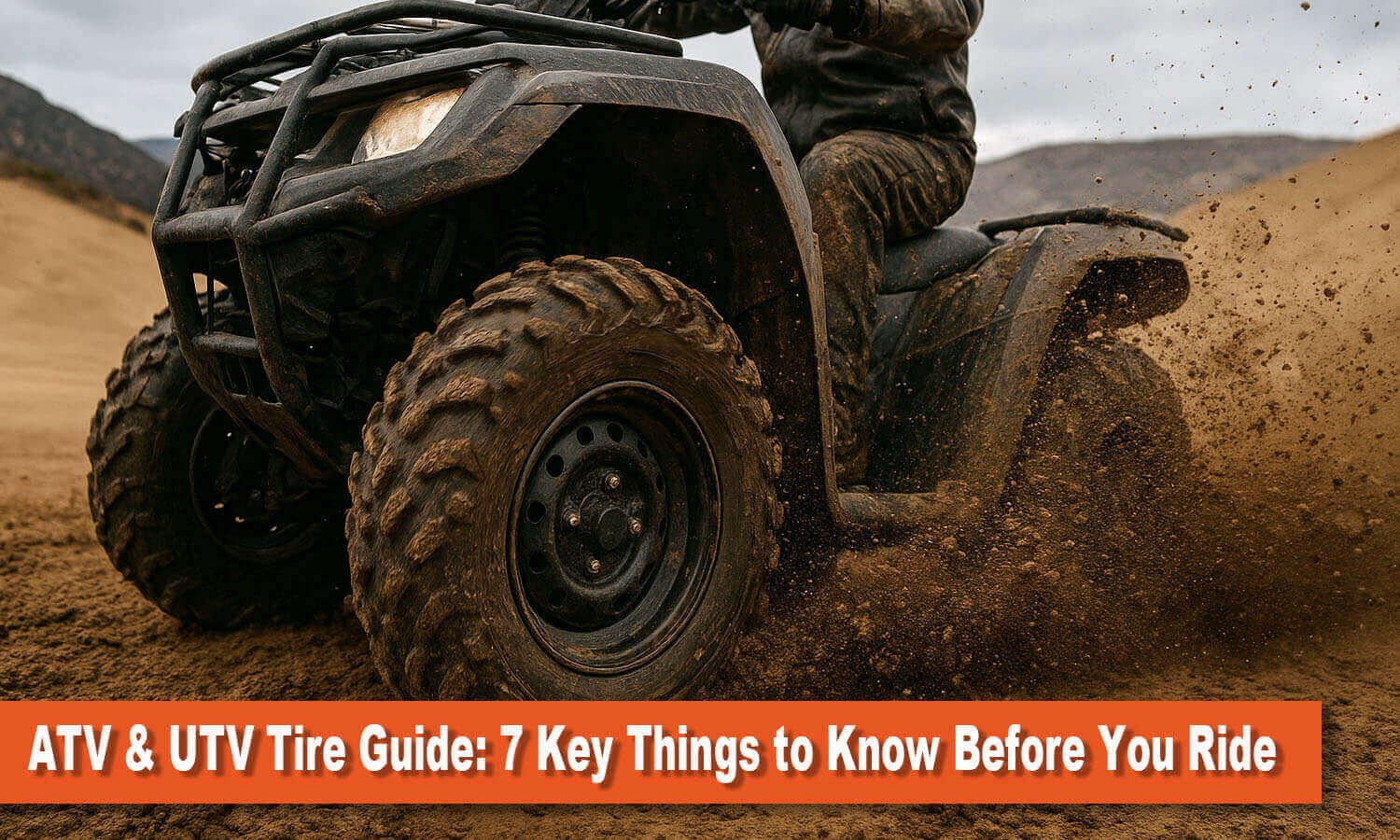
ATV & UTV Tire Choosing Guide: 7 Key Things to Know
Whether you’re powering through muddy trails, climbing rocky slopes, or gliding over sand dunes, your ATV & UTV Tires play a crucial role in performance. The right tires not only improve speed and handling but also help you tackle tough terrain with confidence. Looks are just the surface — tire size, construction, tread pattern, and pressure are what truly matter for safety and performance.
In the next seven key points, we’ll walk you through how to choose the perfect tires for your ATV/UTV ride.
Table of Contents
✅ Pre-Ride Tire Checklist — ATV & UTV Edition
Tick off each item to check your ride’s readiness!
- Right Tire Size — Matches your ATV/UTV manufacturer’s specifications.
- Tread for the Terrain — Mud, sand, or all-terrain pattern that fits where you’ll ride.
- Width & Rim Match — Tire width is correct for your rim size.
- Carcass & Materials — Choose the right layer structure and material for comfort and durability.
- Ply Rating — Strong enough to carry your load, but not too heavy for your ride style.
- Sidewall Condition — No cracks, bulges, or damage; stiffness fits your handling preference.
- Correct PSI — Adjust for terrain and temperature before every ride.
Safety Rating:
Click "Submit Checklist" to evaluate your tire setup now!
7 Keys to Picking ATV/UTV Tires
1. Key Tire Selection Factors
When choosing ATV/UTV tires, start with compatibility.
Check your owner’s manual for the correct tire size and wheel combinations approved for your vehicle. This ensures safe fitment and proper handling.
Next, match the tread pattern to your riding terrain.
- Muddy bogs: Large, widely spaced lugs to shed mud.
- Sandy dunes: Paddle-like ribs for maximum thrust.
- Rocky or mixed trails: Medium-lug all-terrain designs for balanced grip and comfort.
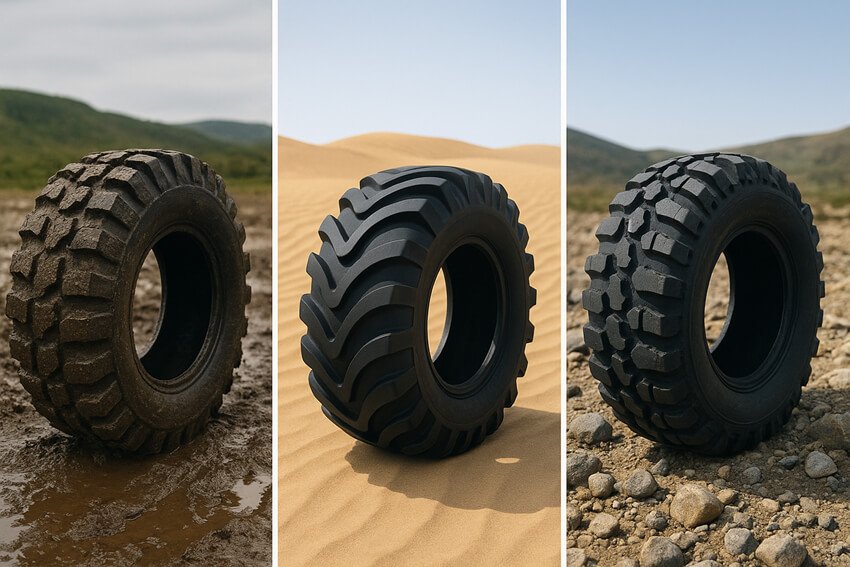
A triptych-style photographic comparison of three ATV/UTV tire designs for different terrains.
Compatibility & Size
Always confirm that the tire’s dimensions (diameter and width) fit your ATV/UTV and its wheels.
Tires that are too large or too small can cause handling problems, interfere with suspension, or even lead to tire blowouts.
Terrain
Choose tires designed for your terrain. Different tires are designed for different terrains – such as mud, sand, snow, or rocky terrain.
An all-purpose tire may work fine for general trail use, but if you often ride in extreme mud or deep sand, use a specialized mud or sand tire.
Tread Pattern
The shape of the treads determines traction. Aggressive, deep-lug tread grips loose mud and snow better, while a smoother, closer-set lug pattern rides quietly on hardpacked trails.
Durability
Off-road tires see rocks and debris.
Look for reinforced sidewalls and carcass for durability. Heavy-duty ratings and puncture-resistant compounds can save you from flats.
Tire Width and Load (Ply Rating)
Ensure the tire width matches your wheel and frame. Wider tires can improve flotation in mud but may rub on narrow suspension components if too wide.
Also note the ply rating: higher is stronger. A common tip is, “ensure the size of the tire matches your ATV’s specifications. The ply rating … indicates the tire's strength and capacity”.
2. Decoding Tire Size Labels
Every ATV/UTV tires sidewall shows its size and key specs. Understanding these codes ensures proper fitment.
Imperial sizes (inches) are written as Diameter × Width – Rim.
Example: 25×10–14 → 25″ overall diameter, 10″ tread width, fits a 14″ rim.
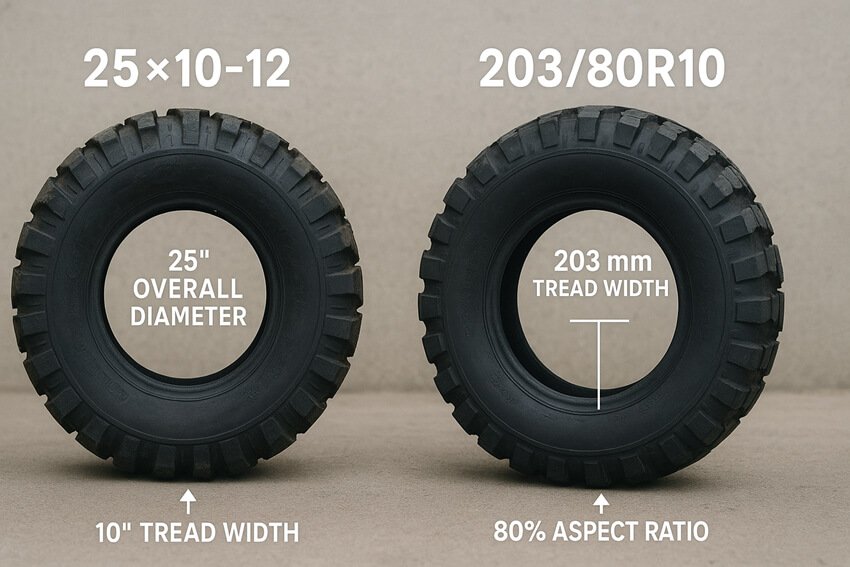
ATV/UTV tire size comparison: 25×10-12 vs 203/80R10
Metric sizes use the format Width / Aspect Ratio R Rim.
Example: 203/80R10 → 203 mm tread width, sidewall height is 80% of 203 mm, fits a 10″ rim.
Always match the tire’s rim diameter to your wheel exactly—never try to mount a 10″ tire on a 12″ rim or vice versa.
Correct sizing ensures the bead seats properly and the tire seals securely.
3. Wheel and Size Compatibility & Tread Types
Tire width and diameter must suit your wheel and frame.
On most ATVs, the rear tires are about 2″ wider than the fronts. If you swap to a much larger tire, check that it has clearance.
For example, if your ATV is rated for 25-inch tires, you can generally go up to 27 inches. Going bigger than that may require a lift kit.
Exceeding the recommended size can cause the tires to rub against the fenders or suspension.
Next, consider tread patterns. Each design suits certain conditions:
- All-Terrain Tires: The most common type, designed for versatility on mixed terrain. They have moderately aggressive lugs and a wider contact patch for traction on dirt, gravel, and some mud. These are often the stock tires on ATVs/UTVs and are a good general choice for trail riding.
- Mud Tires: These feature very large, widely spaced knobs (lugs) to dig into deep mud or sludge. The huge lugs scoop out mud for better grip. Interestingly, mud tires also excel in snow and slush because the wide tread clears mud and snow easily. If you frequently slog through muddy trails, these give you the biggest traction boost.
- Sand (Paddle) Tires: Also called paddle tires, they have big paddle-shaped ribs on the rear tires. These ribs push sand back under them, keeping the ATV on top of loose dunes. “The paddle tire will push the sand backward so you have ample traction,” which makes climbing sand dunes easier. However, they wear very quickly on hard surfaces – riding these tires on anything other than soft sand will ruin them.
- Other Specialized Tires: (Not in the core list but for context) Some users also use rock or trail tires. Rock tires have tight, small lugs and strong sidewalls for crawling over boulders. Snow tires with metal studs or siping help in icy winter conditions.
Choosing the right tread is as important as size.
A tire that’s too aggressive off-road can make the ride choppy on flat trails, while a smooth tire may spin uselessly in deep mud. Always pick a tire whose intended use (all-terrain vs mud vs sand) matches where you ride most.
4. Tire Construction (Carcass) – Layers and Materials
Beneath the tread lies the tire’s carcass (casing) – a stack of fabric or steel layers that give the tire its shape and strength. The casing determines how flexible or stiff the tire is.
Heavy-duty off-road tires often have multiple reinforcement layers (plies) and special inserts. Stronger materials and extra layers make the tire tougher against punctures and heavy loads, but also heavier.
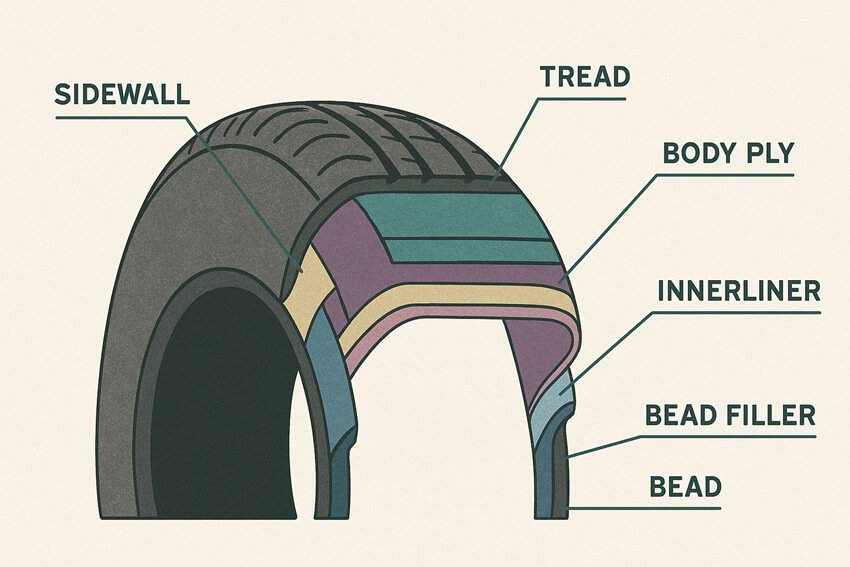
tire construction
Materials
Most ATV/UTV tires are made of nylon or polyester cords, sometimes with steel belts (in radials).
Newer tires may use high-strength synthetic fibers to get the same strength with fewer actual plies.
Sidewall Reinforcement
The sidewall of the tire also plays into the carcass. Many off-road tires have reinforced or thicker sidewalls to resist punctures from rocks.
The sidewall must be strong enough to support the tread under load. The casing and sidewall together absorb shocks and maintain stability.
Impact on Performance
A stiffer carcass (many plies) reduces tire flexing, which can improve handling and reduce rolling (side-to-side wobble). It also increases load capacity.
However, very stiff tires transmit more bumps and vibrations to the rider. Manufacturers balance ply count and materials to get the desired blend of durability and ride comfort.
5. Ply Rating and Bias-Ply vs Radial Tires
Ply Rating: The ply rating (often stamped on the sidewall, e.g. “6-ply” or “8-ply”) is a measure of the tire’s strength.
It roughly corresponds to how many layers are used in the carcass (though modern tires use stronger materials, so a 6-ply rated tire might only have 2–3 actual plies).
A higher number means more capacity; a 6-ply tire is sturdier than a 4-ply, and an 8-ply even tougher.
This is great for heavy loads or very rough terrain, but remember: more plies mean a stiffer, heavier tire, which can make acceleration and handling slightly less sharp.
Bias-Ply vs Radial Construction
Radial tires have plies running radially (at 90° to the direction of travel) and usually include steel belts under the tread. This design separates tread flex from sidewall flex.
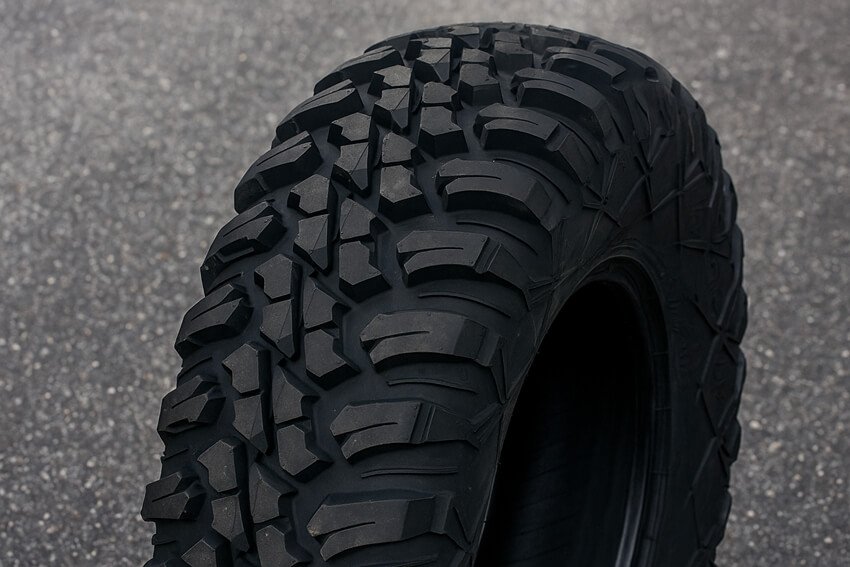
Radial Tires
Benefits:
- Provides a smoother ride
- Offers better traction and handling
- Improves steering and lowers rolling resistance
- Extends tread life
- Rolls more smoothly on flat ground and flexes better to terrain
Drawbacks:
- More expensive to manufacture and buy than bias tires
Bias-Ply Tires
Bias-ply tires have plies that crisscross at angles, with cords running diagonally from bead to bead and overlapping in alternating layers. This design makes the tread and sidewall work together, creating a strong, flexible tire.
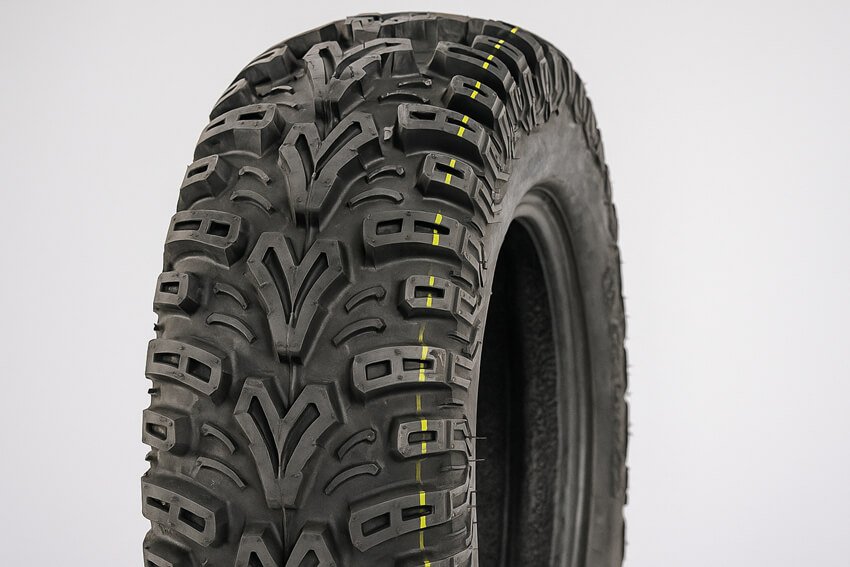
Bias-Ply Tires
Benefits:
- Excellent traction on very rough terrain
- Sidewalls flex to conform to rocks, deep mud, and other obstacles
- Ideal for extreme off-road conditions, such as rock crawling or deep mud riding
Drawbacks:
- Generate more heat
- Higher rolling resistance
- Can feel squirmy at higher speeds
ATV & UTV Tire Comparison: Radial vs Bias-Ply
| Tire Type | Pros | Cons | Best For |
|---|---|---|---|
| Radial | Smooth ride, better handling, longer tread life | Higher price | High-speed trail riding, general use |
| Bias-Ply | Very strong/flexible, excellent traction in mud/rocks, forgiving sidewalls | More vibration, faster wear under aggressive riding | Extreme off-road, hauling, mud-running |
Tip: Choose based on how you ride — speed-focused riders usually prefer radials, while mud-runners or heavy load users may prefer bias-ply.
6. Sidewall Design: Stability vs. Comfort
The tire sidewall (the wall between tread and wheel rim) also affects ride quality and stability. Its construction and flexibility determine how the ATV handles bumps and turns.
Stiffer Sidewalls
A rigid sidewall resists flexing.
This tightens up handling: the ATV will feel more precise and stable in corners, and less prone to wobble under high loads or speeds.
Racing tires or high-speed UTV tires often use tougher sidewalls.
The downside is comfort: hard sidewalls transmit shocks and vibrations straight to the rider, making the ride harsher.
Flexible Sidewalls
A softer sidewall absorbs impacts. It lets the tire bulge a bit over obstacles, cushioning bumps.
This yields a smoother, more comfortable ride on rough trails. Flexible sidewalls can also improve grip, as they allow more of the tread to stay in contact with uneven ground.
However, too much sidewall flex can make steering feel sluggish and can negatively affect high-speed cornering.
Many ATV tires strike a balance. Some special tires include sidewall reinforcements or inserts for extra protection without making them too stiff. If you carry heavy loads or tow, you might prefer stiffer sidewalls. If you want comfort on long trail rides, a bit of sidewall flex is beneficial.
In short, stiffer sidewalls increase stability and responsiveness (at the cost of ride comfort), while softer sidewalls enhance shock absorption and comfort (at the cost of some sharp handling).
7. Tire Pressure (PSI) – Adjusting for Terrain and Conditions
Tire pressure (PSI) is crucial for grip, ride quality, and safety. Proper PSI ensures the tire’s shape and tread engage the ground correctly.
Baseline PSI
Your ATV/UTV or tire sidewall will list a recommended pressure range. For many utility ATVs, this is around 7–12 PSI.
For example, one source mentions standard trail tire pressures of about 7–8 PSI. Always start with the manufacturer’s recommendation printed on the sidewall or in the manual.
Soft Terrain
On sand, mud, or loose dirt, lower the PSI.
Soft ground allows tires to sink and conform, so dropping pressure to 6–8 PSI (or even lower in deep sand) increases the tire’s contact patch and traction. The tire becomes more “balloon-like,” gripping better.
However, be careful – too-low pressure can allow the tire to deform under sharp objects. Always avoid underinflation that risks rubbing the rim.
Hard Terrain
On rock, gravel, or pavement, raise the PSI to firm up the tire.
Higher pressure (around 10–12 PSI or even more for sustained pavement use) prevents pinch flats (when the rim pinches the tire against a rock) and helps the tread keep its shape against hard edges.
Temperature Effects
Air pressure changes with temperature. As a rule of thumb, tire pressure increases by about 2% for every 10°F rise in air temperature, and drops similarly when it’s cold.
So if you fill tires to 10 PSI at 60°F, they’ll read about 10.6 PSI at 100°F. Check PSI when tires are cold for consistency.
Load and Speed
A heavier vehicle or additional cargo requires higher PSI to support the weight.
Also, high-speed riding can heat the tires and increase pressure, so don’t overfill before a fast run. Always stay within the maximum PSI printed on the tire.
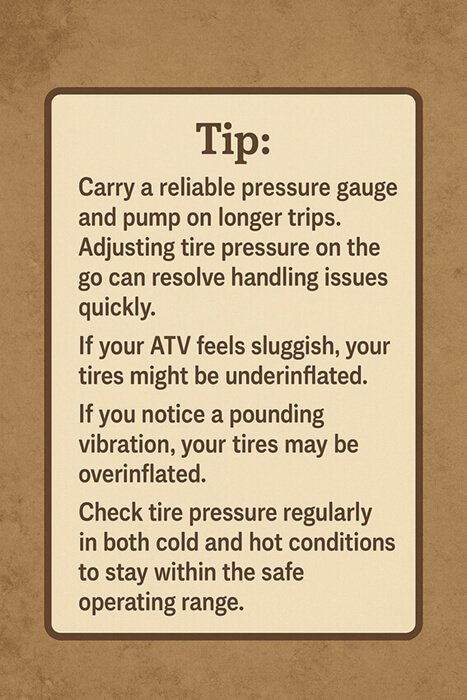 ATV/UTV tires pressure tip
ATV/UTV tires pressure tip
By tuning tire pressure to the ground beneath you, you’ll get better traction, ride comfort, and fewer flats. It’s one of the simplest yet most impactful adjustments for ATV/UTV riders.
❓ Tire Safety FAQs
Match tire size to manufacturer specifications and select a tread pattern designed for your typical riding conditions.
construction and better resistance to punctures, but it can also add weight.
control across different types of terrain.
based on terrain and load, keeping within safe limits.

With over 10 years of experience working on cars and trucks Item Training Supervisor Richard Reina is known around the office as one of our technical experts & real an "automobile person".
His rate of interest began, in his very own words, "at the age of two when his father educated him the distinction in between a Chevy and a Ford. Since then it's been cars regularly."
As a serious lover of practically all things with a motor Richard can address nearly any kind of inquiry related to car upkeep, fixing, or restoration & is a fact professional in electric motor background.
Motorcycle riding is all about the sense of freedom, adventure, and thrill of the open road. But come on—being connected when you ride isn't always an easy thing. Whether you're riding with a buddy, navigating traffic in the city, or long-distance riding, effective communication is crucial. That's where the Fodsports T5 and T6 come in, […]
If you're looking for a new motorcycle intercom system this year, Fodsports has something exciting in store. The company has launched two new Bluetooth helmet intercoms: T1 and T1 Pro. Both models bring upgraded features, sleek design, and high-definition audio quality for riders who want to stay connected, entertained, and safe on the road. But […]
Fodsports T1 and T1 Pro: The Newest Bluetooth Intercoms for Riders. Whether you’re cruising on highways, exploring rugged trails, or commuting daily, clear communication is key. Fodsports is thrilled to launch its latest Bluetooth intercoms: the T1 and T1 Pro. Built for riders who demand reliability, versatility, and crystal-clear sound, these devices redefine how you […]
Many riders who aren't so tall or ladies just starting to ride bikes need to pick out the best Motorcycles for Short Riders and Women. They gotta look for three key things: a seat that's not too high up, a bike that's not too heavy, and something that looks good enough to give them confidence. […]
Fodsports FX 60C vs FX30C Pro: What's new techs are the FX 60C bringing to us? Fodsports is a brand worth-mention for helmet communication and video recording. This brand has established itself as a key player with its innovative Bluetooth camera intercom systems. Recently, Fodsports has released a new camera intercom, the FX 60C. How […]
